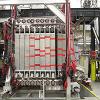
A major experimental capability at Bates, especially during the last years of its operation as a National User Facility for Nuclear Physics, was the Bates Large Acceptance Spectrometer Toroid (BLAST). BLAST was designed to use the storage ring capability of the South Hall Ring along with internal gas targets, including polarized targets. The scientific program provided insight not only into the subatomic scale but also into the astronomic scale. It addressed issues of central importance to intermediate energy nuclear physics: the structure of the nucleon; the spin structure of the weakly bound deuteron system and the three-body 3He system; and the nature of multinucleon absorption mechanisms in electromagnetic reactions.
The design of the BLAST detector consisted of an eight-sector copper coil array which produced a toroidal magnetic field, instrumented with two opposing wedge-shaped sectors of wire chambers, scintillation detectors, Cerenkov counters, Pb-glass calorimeters, and neutron detectors. The open geometry maximized acceptance while allowing good momentum and angular resolution and a luminosity capability well matched to the densities of the polarized internal targets.
When the BLAST experimental run at Bates was complete, the BLAST detector was moved to the DESY laboratory in Hamburg, Germany and was successfully used in the important OLYMPUS experiment at that laboratory.

